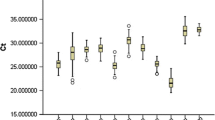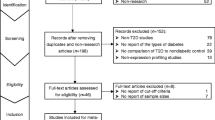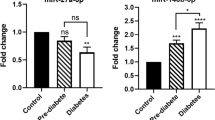Abstract
To explore the clinical significance of seven diabetes-related serum microRNAs (miR-9, miR-29a, miR-30d, miR34a, miR-124a, miR146a and miR375) during the pathogenesis of type 2 diabetes (T2D), 56 subjects were recruited to this study: 18 cases of newly diagnosed T2D (n-T2D) patients, 19 cases of pre-diabetes individuals (impaired glucose tolerance [IGT] and/or impaired fasting glucose [IFG]) and 19 cases of T2D-susceptible individuals with normal glucose tolerance (s-NGT). Serum miRNAs were determined by real-time RT-PCR. Expression levels of single miRNAs and the expression signatures of miRNAs as a panel were analysed among the three groups. In n-T2D, all 7 miRNAs were significantly up-regulated compared with s-NGT and five were significantly up-regulated compared with pre-diabetes, while miRNA expression was not significantly different between s-NGT and pre-diabetes. By Canonical discriminant analysis, 70.6% of n-T2D subjects (12/17) were recognized by canonical discriminant function, while s-NGT and pre-diabetes subjects could not be discriminated from each other. Similar results were found in Hierarchical Clustering analysis based on the expression levels of all seven miRNAs. In different statistical analysis, miR-34a always showed the most significant differences. We conclude that the expression levels of seven diabetes-related miRNAs in serum were significantly elevated in n-T2D compared with pre-diabetes and/or s-NGT, and the latter two groups featured similar expression patterns of these miRNAs, suggesting that during the pathogenesis of T2D, the peripheral diabetes-related miRNAs have not changed significantly from s-NGT at pre-diabetic stage.



Similar content being viewed by others
References
Wild S, Roglic G, Green A et al (2004) Global prevalence of diabetes: estimates for the year 2000 and projections for 2030. Diabetes Care 27:1047–1053
Prentki M, Nolan CJ (2006) Islet beta cell failure in type 2 diabetes. J Clin Invest 116:1802–1812
McCarthy MI, Zeggini E (2009) Genome-wide association studies in type 2 diabetes. Curr Diab Rep 9:164–171
Palmer CN (2009) Novel insights into the etiology of diabetes from genome-wide association studies. Diabetes 58:2444–2447
Sladek R, Rocheleau G, Rung J et al (2007) A genome-wide association study identifies novel risk loci for type 2 diabetes. Nature 445:881–885
Frayling TM (2007) Genome-wide association studies provide new insights into type 2 diabetes aetiology. Nat Rev 8:657–662
Zeggini E (2007) A new era for Type 2 diabetes genetics. Diabet Med 24:1181–1186
Lango H, Palmer CN, Morris AD et al (2008) Assessing the combined impact of 18 common genetic variants of modest effect sizes on type 2 diabetes risk. Diabetes 57:3129–3135
Ji J, Wang XW (2009) New kids on the block: diagnostic and prognostic microRNAs in hepatocellular carcinoma. Cancer Biol Ther 8:1686–1693
Chen X, Ba Y, Ma L et al (2008) Characterization of microRNAs in serum: a novel class of biomarkers for diagnosis of cancer and other diseases. Cell Res 18:997–1006
Gilad S, Meiri E, Yogev Y et al (2008) Serum microRNAs are promising novel biomarkers. PloS One 3:e3148
Mitchell PS, Parkin RK, Kroh EM et al (2008) Circulating microRNAs as stable blood-based markers for cancer detection. Proc Natl Acad Sci USA 105:10513–10518
Huang Z, Huang D, Ni S et al (2009) Plasma microRNAs are promising novel biomarkers for early detection of colorectal cancer. Int J Cancer
Jackson DB (2009) Serum-based microRNAs: are we blinded by potential? Proc Natl Acad Sci USA 106:E5
Tang X, Tang G, Ozcan S (2008) Role of microRNAs in diabetes. Biochim Biophys Acta 1779:697–701
Hennessy E, O’Driscoll L (2008) Molecular medicine of microRNAs: structure, function and implications for diabetes. Exp Rev Mol Med 10:e24
Pandey AK, Agarwal P, Kaur K et al (2009) MicroRNAs in diabetes: tiny players in big disease. Cell Physiol Biochem 23:221–232
Tang X, Muniappan L, Tang G et al (2009) Identification of glucose-regulated miRNAs from pancreatic beta cells reveals a role for miR-30d in insulin transcription. RNA 15:287–293
Baroukh N, Ravier MA, Loder MK et al (2007) MicroRNA-124a regulates Foxa2 expression and intracellular signaling in pancreatic beta-cell lines. J Biol Chem 282:19575–19588
Plaisance V, Abderrahmani A, Perret-Menoud V et al (2006) MicroRNA-9 controls the expression of Granuphilin/Slp4 and the secretory response of insulin-producing cells. J Biol Chem 281:26932–26942
Poy MN, Eliasson L, Krutzfeldt J et al (2004) A pancreatic islet-specific microRNA regulates insulin secretion. Nature 432:226–230
He A, Zhu L, Gupta N et al (2007) Overexpression of micro ribonucleic acid 29, highly up-regulated in diabetic rats, leads to insulin resistance in 3T3–L1 adipocytes. Mol Endocrinol 21:2785–2794
Lovis P, Roggli E, Laybutt DR et al (2008) Alterations in microRNA expression contribute to fatty acid-induced pancreatic beta-cell dysfunction. Diabetes 57:2728–2736
(2009) Diagnosis and classification of diabetes mellitus. Diabetes Care 32(Suppl 1):S62–S67
Ji J, Zhao L, Budhu A et al (2010) Let-7 g targets collagen type I alpha2 and inhibits cell migration in hepatocellular carcinoma. J Hepatol 52:690–697
Wong L, Lee K, Russell I et al (2007) Endogenous controls for real-time quantitation of miRNA using TaqMan MicroRNA assays. Macmillan Publishers Limited (all rights reserved), New York
Roggli E, Britan A, Gattesco S et al (2010) Involvement of microRNAs in the cytotoxic effects exerted by proinflammatory cytokines on pancreatic beta-cells. Diabetes 59:978–986
Feng B, Chen S, George B et al (2010) miR133a regulates cardiomyocyte hypertrophy in diabetes. Diabetes Metab Res Rev 26:40–49
Poy MN, Hausser J, Trajkovski M et al (2009) miR-375 maintains normal pancreatic alpha- and beta-cell mass. Proc Natl Acad Sci USA 106:5813–5818
Quinn GP, Keough MJ (2002) Experimental design and data analysis for biologists. Cambridge University Press, Cambridge
Berezikov E, Guryev V, van de Belt J et al (2005) Phylogenetic shadowing and computational identification of human microRNA genes. Cell 120:21–24
Bentwich I, Avniel A, Karov Y et al (2005) Identification of hundreds of conserved and nonconserved human microRNAs. Nat Genet 37:766–770
Lewis BP, Burge CB, Bartel DP (2005) Conserved seed pairing, often flanked by adenosines, indicates that thousands of human genes are microRNA targets. Cell 120:15–20
Wu Y, Li H, Loos RJ et al (2008) Common variants in CDKAL1, CDKN2A/B, IGF2BP2, SLC30A8, and HHEX/IDE genes are associated with type 2 diabetes and impaired fasting glucose in a Chinese Han population. Diabetes 57:2834–2842
Ruchat S-M, Elks C, Loos R et al (2009) Association between insulin secretion, insulin sensitivity and type 2 diabetes susceptibility variants identified in genome-wide association studies. Acta Diabetol 46:217–226
Zhao J, Bradfield JP, Zhang H et al (2010) Examination of all type 2 diabetes GWAS loci reveals HHEX-IDE as a locus influencing pediatric BMI. Diabetes 59:751–755
Lantz KA, Vatamaniuk MZ, Brestelli JE et al (2004) Foxa2 regulates multiple pathways of insulin secretion. J Clin Invest 114:512–520
Meissner T, Beinbrech B, Mayatepek E (1999) Congenital hyperinsulinism: molecular basis of a heterogeneous disease. Hum Mutat 13:351–361
Dinneen SF, Maldonado D 3rd, Leibson CL et al (1998) Effects of changing diagnostic criteria on the risk of developing diabetes. Diabetes Care 21:1408–1413
Meigs JB, Muller DC, Nathan DM et al (2003) The natural history of progression from normal glucose tolerance to type 2 diabetes in the Baltimore longitudinal study of aging. Diabetes 52:1475–1484
Tirosh A, Shai I, Tekes-Manova D et al (2005) Normal fasting plasma glucose levels and type 2 diabetes in young men. N Engl J Med 353:1454–1462
Tuomilehto J, Lindstrom J, Eriksson JG et al (2001) Prevention of type 2 diabetes mellitus by changes in lifestyle among subjects with impaired glucose tolerance. N Engl J Med 344:1343–1350
Delahanty LM, Nathan DM (2008) Implications of the diabetes prevention programme and Look AHEAD clinical trials for lifestyle interventions. J Am Diet Assoc 108:S66–S72
Acknowledgments
We thank Dr. Thomas T. Tapmeier, Mr. Richard Newton, Dr. Sébastien Serres and Ms. Laura Dean for the careful review of the manuscript. This work was supported by the “Medical Science Development Programme of Shandong Province” from The Health Department of Shandong Province (2007-QW035, 2009-QZ021).
Author information
Authors and Affiliations
Corresponding authors
Rights and permissions
About this article
Cite this article
Kong, L., Zhu, J., Han, W. et al. Significance of serum microRNAs in pre-diabetes and newly diagnosed type 2 diabetes: a clinical study. Acta Diabetol 48, 61–69 (2011). https://doi.org/10.1007/s00592-010-0226-0
Received:
Accepted:
Published:
Issue Date:
DOI: https://doi.org/10.1007/s00592-010-0226-0




